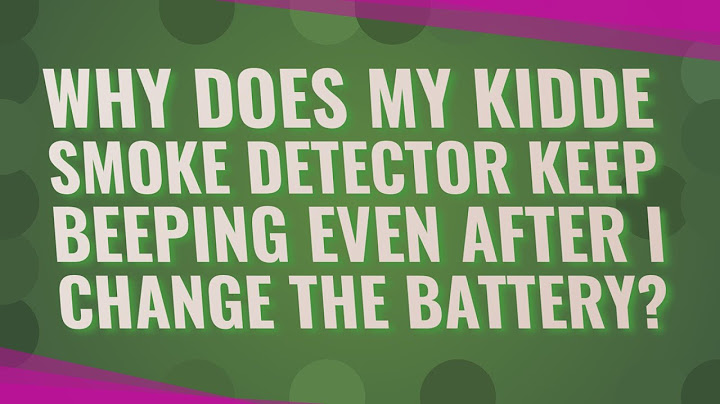Carbon monoxide (CO) is a colorless, odorless gas that can accumulate in closed spaces like a home or office. Prolonged exposure can result in permanent brain damage or even death. When functioning correctly, carbon monoxide detectors alert you to the presence of the toxic gas in time to take life-saving action. But what if your carbon monoxide detector beeps for no apparent reason? Show
While you should take any alarm seriously, carbon monoxide detectors often beep or chirp in non-emergency situations. Here are the most common reasons why a carbon monoxide detector beeps, and what to do when it happens. Causes of Carbon Monoxide Detectors BeepingWhen a carbon monoxide detector beeps or chirps at regular intervals, it is usually because of a problem with the battery or an internal malfunction.
Sources of Carbon MonoxideCarbon monoxide is usually produced in the home by fuel-burning devices, like furnaces, stoves, gas clothes dryers, and fireplaces. Under normal circumstances, these devices release very little carbon monoxide, but that can change if they malfunction. Some sources of carbon monoxide can be avoided through best practices. For example, you should never operate an outdoor grill or propane heater indoors. Generators should be operated a safe distance away from the home, as they create a lot of carbon monoxide during regular operation. Never run a generator inside your garage, even if the garage door is open. Cars can also be a source of carbon monoxide in the home. Never leave a car running in your garage, especially with the garage door closed. Like generators, even running a car near a window or door of your home can cause exhaust fumes to accumulate inside. Most carbon monoxide detectors are designed to be reset after an alarm (real or false), or after replacing the battery. Resetting a carbon monoxide detector is perfectly safe, as long as the device hasn't reached the end of its operational life. After a carbon monoxide detector sounds the alarm, it's critical that you identify and remove the source of carbon monoxide and ventilate the affected area. Emergency responders can check the source of carbon monoxide and remedy the situation. How to Fix a Beeping Carbon Monoxide DetectorIf you've determined that there is not a dangerous buildup of carbon monoxide present, you will have to figure out what caused the alarm. If your carbon monoxide detector sounds an alarm, don't take any chances. Press the test or reset button and then relocate everyone, including pets, to fresh air. Call emergency services, and wait for them to provide the all-clear before reentering the structure. Here are the steps to take if your carbon monoxide detector is beeping:
How to Reset a Carbon Monoxide DetectorTo reset a carbon monoxide detector, you must first connect it to a power source or install a fresh battery. In most cases, the reset process is automatic, so the goal is to silence the alarm while the detector resets itself. If the detector was exposed to carbon monoxide, then move it to an area with fresh air before resetting it.
Smart Carbon Monoxide Detectors BeepingSmart carbon monoxide detectors are designed to provide more information than conventional units. They can link to your smart home system through a smart home hub. Usually, they allow you to control the detector through an app on your smartphone. Smart carbon monoxide detector apps usually provide basic controls, like the ability to silence the alarm, which is useful during the reset procedure. Some of these apps are also designed to offer useful diagnostic information as well, which can help in troubleshooting a false alarm. Since smart carbon monoxide detectors are designed to provide additional information through the connected app, you should make sure to check your app in addition to the steps outlined above. The problem may be still be due to the battery, but the app can help pinpoint the complication if you are experiencing another type of failure. Thanks for letting us know! Get the Latest Tech News Delivered Every Day Subscribe How do I get my carbon monoxide detector to stop beeping?To reset the alarm, the unit needs fresh air and time to burn the contamination off the sensor. Push and hold the silence button for 5 seconds to silence the alarm while contamination is being burned off the sensor. You may need to do this a number of times to give the carbon monoxide alarm enough time to reset.
Why is my carbon monoxide detector beeping every 40 seconds?Low Battery – The alarm will chirp every 30-40 seconds (every 60 seconds for some alarms) for a minimum of seven days. Replace the battery when this occurs, then test your alarm.
Why is my carbon monoxide detector continuously beeping?Continuous Four-Beep Alarm Pattern
Your alarm may have detected carbon monoxide. Make sure that you know how to respond to a CO emergency. You may be experiencing a nuisance alarm.
How do I know if my carbon monoxide detector needs a new battery?1 beep every minute: This means that the detector has low batteries and you should replace them. 5 beeps every minute: This means your alarm has reached the end of its life and needs to be replaced with a new carbon monoxide alarm.
|

Related Posts
Advertising
LATEST NEWS
Advertising
Populer
Advertising
About

Copyright © 2024 muatrau Inc.

















